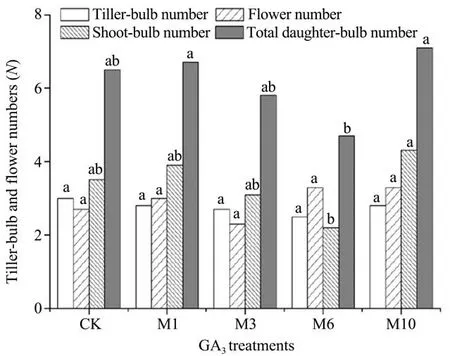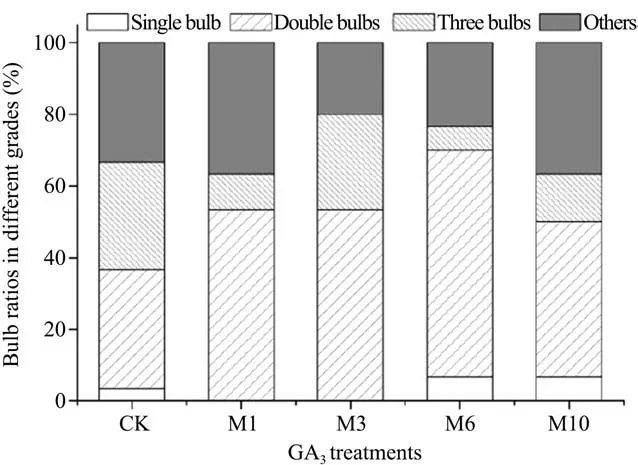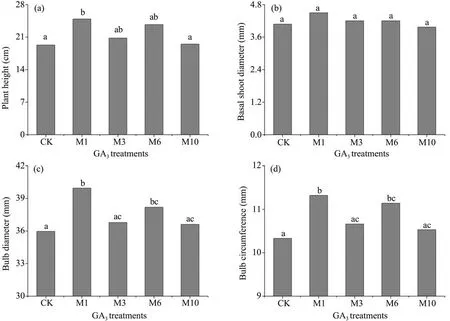Effects of gibberellic acid on tiller-bulb number and growth performance of Lilium davidii var.unicolor
YuHui He,ZhongKui Xie,XinPing Liu,YaJun Wang,YuBao Zhang,Yang Qiu
Department of Ecology and Agriculture,Northwest Institute of Eco-Environment and Resources,Chinese Academy of Sciences,Lanzhou,Gansu 730000,China
ABSTRACT Lilium davidii var.unicolor(Lanzhou lily)is an important economic crop in the northwest cold and arid regions of China.Effective regulation of tiller-bulb development and plant growth is the key to improving yield and quality of the lily.This study attempted to evaluate the effect of gibberellic acid (GA3) on tiller-bulb development and plant growth of Lanzhou lily by applying GA3 at various concentrations (0 mg/L, 10 mg/L, 30 mg/L, 60 mg/L, and 100 mg/L) before planting and in the seedling period. Results showed that the 60-mg/L GA3 application had an inhibiting effect on tiller-bulb formation and increased the ratios of single and double bulbs but decreased the ratios of bulbs with three or more tiller bulbs,as compared to the control (CK) and other GA3 treatments. The difference in flower number did not reach significant levels among the treatments. The tillering-related endogenous hormones IAA (indole-3-acetic acid) and Z (zeatin) content decreased, while IAA/Z increased with the 60-mg/L GA3 treatment during tiller initiation.And also, the shoot-bulb number and total daughter-bulb number decreased significantly with the 60-mg/L GA3 treatment. Furthermore, the 10-mg/L GA3 application promoted growth of Lanzhou lily significantly and resulted in an increase in plant height; bulb diameter; bulb circumference; and biomass of shoots, bulbs, fibrous roots, and the whole plant. Therefore, GA3 application is promising as a new regulation method for inhibiting tiller-bulb development and promoting bulb growth in Lanzhou lily production.
Keywords:Gibberellic acid;tiller bulb;endogenous hormone content;height;biomass
1 Introduction
Lilium davidii var.unicolor (Lanzhou lily) is a native variant in China; and it is an important economic bulb crop that is distributed mostly in Gansu, Ningxia,and neighboring northwest cold and arid regions of China (Qiu et al., 2018). It is the best edible lily as well as a traditional medicinal plant due to its abundant nutrient substances and nourishing effect (Li et al., 2014). Besides, it also has ornamental value and gardening uses for its flaming and flamboyant color(Wang et al., 2010). In Lanzhou lily production, the formation of new daughter bulbs from a mother bulb is a common way of commercial bulb production;but too many tiller bulbs seriously influence lily quality, commodity value, and, to some extent, nutrition(Lü et al., 2009; Yang et al., 2011). Tillering regulation has important physiological, ecological, and agricultural significance. And also, the single-bulb lily is easy to process and convenient for commercialization.Studies have shown that reducing ineffective tillers(or branches) is directly related to increasing crop yield; cultivating crops with few tillers has always been one of the main objectives of crop domestication(Yang, 2015). In recent years, tiller-bulb numbers have increased and bulb quality has deteriorated continuously, becoming the main problems in Lanzhou lily production due to extensive planting and management measures (Yang et al., 2011). Therefore, exploring potentially effective regulation methods and cultivation technology for inhibiting tiller-bulb number and promoting growth performance is becoming an imperative need for improving the yield and quality of Lanzhou lily.
Gibberellic acid (GA3), one of the main growth regulators, has a profound effect on plant growth; it has been used on more than 40 different plant species(including many fruits and vegetables) in horticulture and agriculture worldwide (Reig et al., 2011; Alexopoulos et al., 2016). Many studies have confirmed that GA3application is an effective way to influence plant development and improve crop production(Sumanasiri et al., 2013; Wilhelm, 2015). Not only does GA3have a positive effect on leaf expansion,stem elongation, flower initiation, and fruit and plant development (Fahad et al., 2015; Zang et al., 2016),but also it was effective for controlling tiller buds in crops (rice), due to regulating of the indole-3-acetic acid (IAA) or zeatin (Z) contents in the plants (Liu et al.,2011b).Researchers have suggested that the inhibitory effect of GA3on tillering was usually achieved by applying GA3directly on the tiller bud or on the bud-emergence site (Cai et al., 2013). However, little knowledge is available on how to regulate tiller bulbs in lily crops because it is difficult to apply GA3on the tiller bulb directly, as with rice, due to the tiller bulb being closely enclosed by outer scales in the lily.However, some researchers followed with interest the effects of plant-growth regulators on the flowering of cut lily and cutting propagation of lily scales; and they found that treatment with GA3was the most apt to produce high-quality cut flowers and bigger bulblets of cut lily (Mortazavi, 2011; Yang et al., 2015).There are no reports on field studies to control tiller bulbs and promote growth of lily bulbs by applying GA3.
The objective of this study was to determine if GA3could regulate tiller-bulb and flower number by seed soaking and foliar spraying; to evaluate the impact of GA3on endogenous IAA and Z contents,which are related to tillering; and to determine the effect of GA3application in improving the growth and biomass of Lanzhou lily in the field.
2 Materials and methods
2.1 Experiment design and treatment s
The experiment was conducted in the field nearby Shenlin Flower, Fruit and Vegetable Demonstration Center (35°34′12″N, 105°54′00″E) in Longde County of the Ningxia Hui Autonomous Region, China. This area is one of the major new cultivated areas of Lanzhou lily. The elevation is 1,779 m, annual rainfall 502 mm,annual average temperature 5.3 °C; and the frost-free period is about 125 days. In the spring, we selected seed bulbs of Lanzhou lily that had been propagated at-4°C for the study,then soaked them with GA3solution at 10 mg/L, 30 mg/L, 60 mg/L, or 100 mg/L;the control was soaked with water. The whole seed bulbs were immersed in the GA3solutions for 12 hours,then taken out and air-dried until there was no water on the bulbs' surface. Those bulbs were planted in the test field.Before planting,the test field was thoroughly tilled, leveled, and then divided into experimental plots of 4.0m×3.8m. The furrow planting pattern was adopted, and the planting density was 10,000 N/hm2.Each treatment had three repetitions, and experimental plots were arranged randomly. Then in the seedling period, foliar sprayings of GA3were twice conducted at the same concentration as the soaking—0 mg/L, 10 mg/L, 30 mg/L, 60 mg/L, or 100 mg/L.The first spraying was when all bulb seedlings had sprouted, and the second spraying was in the early days of the budding stage (thirty days after the first spraying).We defined GA3-application treatments of 0 mg/L,10 mg/L, 30 mg/L, 60 mg/L, and 100 mg/L as CK,M1, M3, M6, and M10, respectively. After planting,uniform cultural management, including weeding and irrigation, was followed in all treatments during the entire study period.
2.2 Hormonal extraction and analysis
The two endogenous hormones (IAA and Z) related to tillering in lily buds were analyzed at the ninth day after sowing. The measurement was made at this time because new tiller bulbs of Lanzhou lily begin to emerge around the bud's base about 9-10 days after sowing, according our previous observation and the primary report (Lü et al., 2009). The high-performance liquid-chromatography method was used for analyzing hormone content. Bulb samples for determining hormone content were taken at the ninth day after planting,and ten bulbs were in each sample.The hormonal analysis was performed with an Agilent 1,200 high-performance liquid chromatograph (Agilent,Santa Clara, CA). Two main hormones in the plant,IAA and Z were separated using mobile phase, compounded with methanol (A), acetonitrile (B), and 0.05% (v/v) acetic acid (C), at 20 °C and a flow rate of 0.6 mL/min. The hormones were detected under 270 nm and at retention time of 0-7 minutes for Z,270 nm and least time for IAA (Yang et al. 2015).Peak identity and quantity were determined by comparing with external standards. Data were acquired with an Agilent chromatography workstation.
2.3 Field sampling and measurements
Periodically, we determined plant height during the experiment and counted manually the number of flowers per plant over the flowering season. Then,thirty randomly selected plants of each plot were sampled and harvested when most leaves turned yellow.Plant height was measured in cm from the plant base to the top edge of the leaf by using a ruler, and basalshoot diameter was measured in mm with a vernier caliper. After that, the whole plant was dug out,marked, then bagged before being taken back to the laboratory. Shoot-bulb number, tiller-bulb number,and total daughter-bulb number were counted manually; and the number of single bulbs (bulb with no tiller bulb), double bulbs (bulb with one tiller bulb), three bulbs (bulb with two tiller bulbs), and other bulbs(bulb with three or more than three tiller bulbs) was recorded; then the bulb ratios in the different grades were calculated. Bulb diameter was measured in mm with a vernier caliper in two vertical directions and the average calculated, and bulb circumference was measured by using a measuring tape at the middle of the bulb. The plant was separated into shoots, leaves,shoot bulb, tiller bulb, scales (including scales of mother and daughter bulbs), fleshy roots, and fibrous roots. Each part was rinsed with tap water to clean soil from the surface, then oven-dried at 75 °C to a constant weight,and weighed as the dry weight of biomass of each part.
2.4 Statistical analysis
The growth and biomass data were analyzed by using SPSS 15.0. The means were tested by the leastsignificant-difference method at P=0.05 (LSD 0.05).The correlations among bulb quality and plant-growth characteristics were analyzed with the Pearson correlation method.
3 Results
3.1 Impact of GA3 application on tiller-bulb and flower numbers
Although the difference of mean tiller-bulb number and flower number among treatments had not reached a significant level (P >0.05), the flower number showed an increasing trend with increasing GA3concentration; and the number of tiller bulbs was slightly fewer at the 60-mg/L GA3treatment (M6)(Figure 1). Meanwhile, the analysis of bulb ratios in different grades showed that single- and double-bulb ratios were significantly higher with GA3treatments than in the control(Figure 2).Especially at the 60-mg/L GA3treatment (M6), the single- and double-bulb ratios were obviously higher than for other treatments;and together were 33.4% higher than that of the control; but the ratios of three bulbs and more than three bulbs at the 60-mg/L GA3treatment were significantly lower than at other treatments (Figure 2). In addition, shoot-bulb number and total daughter-bulb number had significant difference (P ≤0.05) among treatments; the greatest numbers of shoot bulbs and total daughter bulbs were observed at the 100-mg/L GA3(M10) treatment, while the fewest shoot bulbs and total daughter bulbs were at the 60-mg/L GA3(M6)treatment(Figure 1).

Figure 1 Tiller-bulb and flower numbers of Lanzhou lily at different GA3-application treatments

Figure 2 Bulb ratios in different grades at different GA3-application treatments
3.2 Impact of GA3 application on endogenic hormones related to tillering
The content of endogenic hormones (IAA and Z)related to tillering in buds had significant difference(P ≤0.05) among treatments, and both increased then decreased and increased again with GA3concentration increasing during tillering differentiation (Figure 3a).The lowest IAA and Z contents were both observed at the 60-mg/L GA3(M6) treatment, and the highest at the 100-mg/L GA3(M10) treatment (Figure 3a). The ratio of IAA/Z increased first then decreased with increasing GA3concentration. The largest IAA/Z ratio was attained at the 60-mg/L GA3treatment(M6)(Figure 3b).

Figure 3 IAA and Z contents in buds at different GA3 treatments
3.3 Impact of GA3 application on plant growth and biomass
GA3treatments enhanced plant height, especially the 10-mg/L GA3application (M1), which promoted plant-height growth significantly (P ≤0.05)and resulted in the highest plant height (Figure 4a). There was no significant difference in basal shoot diameter among the four GA3treatments and CK (Figure 4b).Bulb diameter and bulb circumference were both greater with GA3application than in the control and were significant at the 10-mg/L (M1) and 60-mg/L(M6) GA3treatments (Figures 4c, 4d). The maximum bulb diameter and bulb circumference were both observed at the 10-mg/L GA3(M1) treatment (Figures 4c,4d).

Figure 4 Plant height,basal shoot diameter,bulb diameter,and bulb circumference of Lanzhou lily at different GA3 treatments
All GA3treatments promoted bulb-biomass accumulation, as contrasted to the control; and there was significant difference (P ≤0.05)in bulb biomass among treatments(Table 1). The maximum bulb biomass was observed at the 10-mg/L GA3application-treatment(M1), with an increase of 30.97%, as compared to the control(Table 1).Shoot biomass also reached the maximum at the 10-mg/L GA3treatment (M1) and was significantly (P ≤0.05) more than CK (Table 1). Leaf biomass did not differ significantly among the four GA3treatments and CK.Shoot-bulb biomass differed significantly (P ≤0.05) only between M3 and M6 (Table 1).Fleshy-root biomass was not significantly different among the five treatments, but the difference for fibrous-root biomass was more marked (P ≤0.05) at the 10-mg/L GA3application (M1), as compared with the control (CK) or the 100-mg/L GA3(M10) treatment(Table 1). Scale biomass and whole-plant biomass were significantly enhanced by the 10-mg/L GA3(M1)application and were 30.85% and 32.21% higher,respectively,as contrasted to the control(Table 2).Furthermore, aboveground biomass and root biomass also presented increasing trends in the four GA3-application treatments,as compared to the control(Table 2).

Table 1 Different organ biomasses(g)of Lanzhou lily per plant at different GA3-application treatments

Table 2 Biomass allocation(g)of Lanzhou lily per plant at different GA3-application treatments
3.4 Correlation of bulb quality and plant-growth characteristics under GA3 application
Bulb biomass was positively correlated with plant height and biomass of shoots, leaves, roots and aboveground biomass; and significantly and positively correlated with bulb circumference, bulb diameter,and basal-shoot diameter; but bulb biomass was slightly negative in relation to tiller-bulb number (Table 3). Bulb circumference was remarkably positively correlated with plant height,basal-shoot diameter,and bulb diameter. Bulb diameter was also markedly positively correlated with plant height and basal-shoot diameter, and was significantly positively correlated with the biomass of shoots and roots(Table 3).
4 Discussion
4.1 Impact of GA3 application on tiller bulbs and tillering-related endogenic hormones
Tiller formation is inhibited by apical dominance;GA3is known to have the physiological function of promoting apical dominance and inhibiting tiller growth in plants (Prasad and Cline, 1987; Liu et al.,2011a). For Lanzhou lily, the occurrence of tiller bulbs is actually the result of lateral-bud germination at the base of the mother bulb. In the present study,we investigated the effect of GA3in controlling tiller formation and found that the 60-mg/L GA3-application treatment on Lanzhou lily increased the singlebulb ratio and the double-bulb ratio obviously but decreased significantly the ratio of three or more bulbs,in contrast to other treatments, though the difference among treatments of mean tiller-bulb number did not reach significance. Meanwhile, the lowest shoot-bulb number and total daughter-bulb number were observed at the 60-mg/L GA3application. This finding was consistent with a previous report that exogenous 50 mg/L GA3application inhibited the tiller-bud growth of rice, and endogenous IAA and Z+ZR (zeatin riboside) played key roles in regulating the growth of tiller buds (Liu et al., 2011b). Similarly, it was found that the 60-mg/L GA3application reduced the IAA and Z content in the lily bud but increased the IAA/Z ratio during tillering occurrence in the present study. These results confirmed that applying GA3could inhibit the growth of tiller buds, and the inhibition of Z content and the increase of the IAA/Z value could be the main factor in GA3inhibiting the growth of tiller buds in tillering crops (Liu et al., 2011a; Cai et al., 2013). However, it should be noted that the inhibition effects of GA3on tiller bulbs of Lanzhou lily were not as significant as on rice; this result may be related to the GA3concentration and site of application.As contrasted to rice and other plants, it was difficult to apply GA3directly on the tiller buds, which were covered with outer scales in Lanzhou lily, which may limit the inhibitory effect of GA3on tiller buds.Hence, GA3application had an inhibiting effect on lily tillering; moderate GA3concentration (60-mg/L GA3application)seemed to be more effective for Lanzhou lily, but the optimal application patterns still need further investigation.

Table 3 Correlation of bulb quality and other growth characteristics under GA3 application
4.2 Impact of GA3 application on flower number
Previous research suggested that gibberellins, especially GA3, influenced flower production and could enhance or reduce the flower number of plants, with the effect related to the concentration. For instance,it was found that applications of GA solution at 500-ppm concentration resulted in maximum flower yield of calla lily (Mortazavi, 2011); 100-mg/L GA3promoted the highest number of flowers per stem in the bulbous plant ranunculus (Hort et al., 2009). Other authors also reported that 50-mg/L or higher concentrations of GA3reduced flowering in loquat (Reig et al., 2011). In practical production of Lanzhou lily,people believed that too many flowers would influence the growth of bulbs and scales, with fewer flowers being beneficial for increasing bulb biomass. In the present study, flower numbers of Lanzhou lily showed in an increasing trend with increases in GA3concentration, though the difference among treatments did not reach significance, which may be because the flower was not the main reproduction means for Lanzhou lily. These results indicated that the response of plants' flowering to GA3application not only depended on the concentration applied but also was related to species studied(Mortazavi,2011).
4.3 Impact of GA3 application on plant growth and biomass
Plant height is an important criterion for indicating plant growth. GA3application has been proved to regulate plant-height growth by many researchers.Vengadesan et al. (2002) reported that a 60-mg/L GA3application was the most effective for shoot elongation in Acacia sinuate. And Al-Khassawneh et al.(2006) reported that a 250-mg/L GA3spray promoted the greatest increase in height of black iris (Iris nigrican D.). Ramzan et al. (2014) also reported that bulbs receiving a preplant treatment with GA3solution exhibited more plant height in a study of tulip growth,but the effective rate was 100-mg/L. Similarly, GA3application promoted plant height, as compared to the control; especially, the 10-mg/L GA3application significantly increased plant height of Lanzhou lily in this study. It indicated that GA3application by preplant soaking and seedling spraying was beneficial for plant-height growth of Lanzhou lily, and lower-concentration GA3application improved plant height markedly. Those results confirmed that GA3influenced plant height (shoot-elongation capacity), but the most effective concentration of GA3application that influenced plant height growth varied with plant species(Hopkins,1999;Pavlista et al.,2012).Bulb diameter and bulb circumference were also affected by GA3application.The present work found that GA3application increased bulb diameter and circumference,notably in the 10-mg/L GA3application treatment.Previous research also suggested that GA3application resulted in an increase in diameter of tulip daughter bulbs, as compared to other treatments (Ramzan et al.,2014).In addition,researchers suggested that bulb diameter and circumference influenced bulb yield in bulb-crop production (Zencirkiran and Tumsavas,2006). This finding was in agreement with results showing that bulb diameter and circumference were significantly positively correlated with bulb biomass;and the maximum bulb biomass was observed at the 10-mg/L GA3application treatment.
As a kind of hormone with a wide range of physiological functions in plants, gibberellic acid was often used to enhance growth and improve shoot and root biomass of many plants, including many fruits and vegetables (Gangwar et al., 2011; Saleem et al.,2015).This study about Lanzhou lily also showed that the 10-mg/L GA3application significantly increased biomass of shoots and fleshy roots, as compared to the control, while the 100-mg/L GA3application increased fibrous-root biomass markedly over that of the control. These results indicated higher-concentration GA3application significantly promoted fibrousroot growth, but lower-concentration GA3application significantly promoted shoot and fleshy-root growth of lily. Above results confirmed the conclusion that GA3promoted vegetative growth and was a positive regulator for root growth (Fu and Harberd, 2003).Meanwhile, though all GA3applications tended to enhance biomass of different parts of Lanzhou lily, only the lower-contention GA3application (10 mg/L) significantly increased bulb, scale, and whole-plant biomass by 30.97%, 30.85%, and 32.21%, respectively,as compared to the control. Bulb, scale, and wholeplant biomass were obviously enhanced in lower-concentration GA3application in our study. This finding was in agreement with the conclusion drawn by Einhorn et al. (2013) that sweet cherry size and quality were improved by applying low rates of GA3. But it was in contrast to results reported in Solanum nigrum by Ji et al. (2015), that higher-concentration GA3application significantly increased the biomass by 56%.These findings indicate that GA3has a positive effect on plant growth and biomass accumulation (Fahad et al., 2015); and similar to the effect on sweet cherry,lower-concentration GA3application was more effective for improving biomass of Lanzhou lily.
5 Conclusions
The present study showed that GA3-application treatment affected tiller bulbs, flower number, and growth performance. The 60-mg/L GA3application led to the lowest shoot-bulb number and total daughter-bulb number; increased the single- and doublebulb ratios obviously; but decreased the three-ormore-bulbs ratio significantly. Meanwhile, contents of the tillering-related hormones IAA and Z were the lowest; but the IAA/Z ratio was the largest in buds at the 60-mg/L GA3-application treatment during tiller occurrence. GA3application promoted plant growth and biomass accumulation of Lanzhou lily; especially,low GA3application at 10 mg/L effectively increased plant height; bulb diameter; bulb circumference; and biomass of shoots, bulbs, fibrous roots, and the whole plant. As a result, GA3has a promising application prospect in inhibiting tiller-bulb number and improving bulb quality.
Acknowledgments:
This work was supported by the Science and Technology Service Network Initiative of the Chinese Academy of Sciences (Grant No. KFJ-STS-QYZD-120), the Gansu Province Major Project of Science and Technology (Grant No. 18ZD2NA010), and the National Natural Science Foundation of China (Grant No.41801076). The authors would like to thank Dr. Liu Yang for her help in the experiment.Also, the authors are very grateful to the anonymous reviewers and editors for their critical reviews and comments that helped to improve the manuscript.
 Sciences in Cold and Arid Regions2019年4期
Sciences in Cold and Arid Regions2019年4期
- Sciences in Cold and Arid Regions的其它文章
- Holocene lake carbon sequestration,hydrological status and vegetation change,China
- Comparative study of surface energy and land-surface parameters in different climate zones in Northwest China
- A paleo-hydrological simulation experiment and its verification in an inland basin
- Influence of frost weathering on the recession of surfaces of technogenic landforms in Yakutia
- Editors-in-Chief Guodong Cheng and Ximing Cai
- Guidelines to Authors
